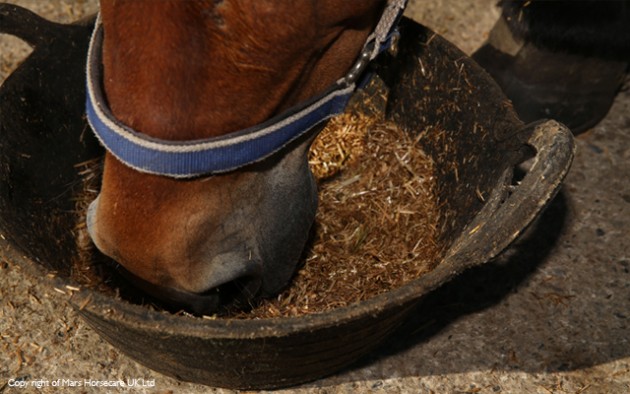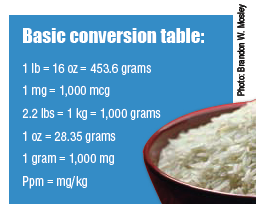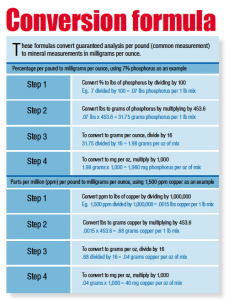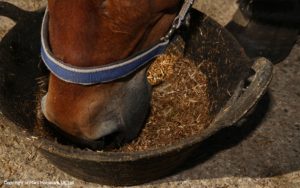Equine Nutrition: Understanding Labels

Nowadays, marketing strategies can make any supplement or feed seem like the next miracle product. Going by all the claims out there, we should have a world full of healthy horses. Unfortunately, this isn’t so. Luckily, armed with some basic information about equine nutrition, any horse guardian can sort out the good, the bad and the ugly.
An ability to look past the fancy marketing and packaging and really understand what labels are telling you will give your equine partner a much better chance at a balanced diet. Total equine nutrition is a complex subject beyond the scope of this article, but knowledge of some basic guidelines such as ingredients, key ratios and comparison techniques will help you understand labels and make more informed decisions.
What’s really in concentrated feeds?
This category of products includes a feed base with added vitamins and minerals, either in sweet feed form or pellets. These feeds are very common and designed for convenience. Unfortunately, due to over-processing and often second-rate ingredients or fillers, they are often not a good choice when it comes to well-balanced equine nutrition.
The first step in reading a feed label and determining equine nutrition is to look at the ingredient list. Watch for sub-standard filler products. Keep in mind that the first listed ingredients are often in order of the amount in the overall mix. Here are some common ingredients to watch for:
• Wheat middlings: A by-product of wheat milling and an inexpensive filler with little nutritional value.
• Artificial flavorings: Undisclosed synhetic materials that are not overseen by the USDA.
• Alfalfa meal or Bermuda straw: Filler ingredients with very low nutritional value often made from poor quality and older hay. Green dye is often added to enhance the color.
• Soybean or oat hulls: The outer covering of the grain or seed left over after the nutritious portion is milled. Another inexpensive filler.
• By-products: This term is more commonly seen in dog and cat food but also in some horse feeds. A by-product is left over from processing another material. There is no law governing what is considered a by-product.
Beneficial levels or not?
Some concentrated feeds also contain ingredients that may be pleasing to the horse guardian’s eyes but aren’t at levels that could benefit the horse. Two common ones are MSM, a source of sulfur and a joint health aid, and probiotics. Often, the amount of MSM listed in the guaranteed analysis is way below the maintenance dose of ten grams per day. With probiotics, only one or two strains of beneficial bacteria are often added where a minimum of six or seven are needed by the horse’s intestinal track. This doesn’t necessarily rule out such products, but additional supplementation with specialty products will be needed.
What about starches and sugar?
A low starch/sugar diet is extremely important for easy-keeper breeds who may be prone to insulin resistance, as well as Cushing’s horses, although the “better safe than sorry” approach may be appropriate with most horses. If grain use is warranted, such as with high competition horses, a small quantity of high quality whole oats is much better than lower quality, over-processed grain materials.
Ingredients contributing to starch and sugar in feeds include grains and also molasses, which can wreck havoc on a horse’s glucose levels. Molasses is often added to concentrated products to make it palatable to horses. It’s high in sugar and over-taxes the liver. Some companies aiming for a low starch/ sugar diet are using the strategy of including inferior grain ingredients such as middlings or hulls; although low in starch, these are also low in nutritional value. Quality companies are using rice bran, flaxseed and/or beet pulp.
What effect does overprocessing and storage have?
Most concentrated feed products are highly processed mechanically and by heat. This destroys beneficial enzymes as well as some of the vitamins and minerals originally added to the product. These nutrients, which are beneficial when it comes to balanced equine nutrition, can further decrease over time (shelf life) and by interacting with all the other ingredients.
Comparing products
With so many choices and variations in formulas, it’s easy for any horse owner to throw up her hands in frustration. There is no easy answer and there is no miracle product that will be appropriate for every horse. Numerous factors come into play such as age, discipline, other feedstuffs, environment and even the horse’s individual metabolism.
One thing that makes it hard to compare products is the units of measure used in the guaranteed analysis. Some minerals are listed as a percentage, some as ppm (parts per million), grams or milligrams. To further complicate things, these can be based per pound, ounce or serving size. In order to compare various products or look at key ratios, common measurements must be used (see sidebar).
Be aware of key ratios
Mineral balance is a very complex issue because so many minerals interact with each other. For instance, an excess  of one can lower the absorption of others, as with calcium and magnesium. When reading a guaranteed analysis, be sure to look at the following key mineral ratios, aiming for a close but not often a perfect match. Horses are tolerant of small variances in these ratios so perfection is not necessary and can be tweaked if needed.
of one can lower the absorption of others, as with calcium and magnesium. When reading a guaranteed analysis, be sure to look at the following key mineral ratios, aiming for a close but not often a perfect match. Horses are tolerant of small variances in these ratios so perfection is not necessary and can be tweaked if needed.
• Calcium: phosphorus: magnesium 2: 1: 1
• Copper: zinc: manganese 1: 3: 3
• Copper: iron 1: 6
• Potassium: sodium 4: 1
 Are natural sources different from manmade? Many holistic experts agree that nutrients from natural sources or in basic forms are assimilated and metabolized by the body more efficiently than their synthetic counterparts. Pat Coleby, author of numerous books on eco-farming and holistic health for animals, states in Natural Horse Care, “1 mg of organic selenium (as in kelp) is equal to 4 mg inorganic selenium in terms of utilization.” Therefore, if more natural sources are used in a supplement, the guaranteed analysis may seem low compared to a product containing synthetic or chelated minerals. The results on whether this is true then rest on the horse, his physical state and perhaps a Hair Mineral Analysis.
Are natural sources different from manmade? Many holistic experts agree that nutrients from natural sources or in basic forms are assimilated and metabolized by the body more efficiently than their synthetic counterparts. Pat Coleby, author of numerous books on eco-farming and holistic health for animals, states in Natural Horse Care, “1 mg of organic selenium (as in kelp) is equal to 4 mg inorganic selenium in terms of utilization.” Therefore, if more natural sources are used in a supplement, the guaranteed analysis may seem low compared to a product containing synthetic or chelated minerals. The results on whether this is true then rest on the horse, his physical state and perhaps a Hair Mineral Analysis.
Equine nutrition is very important for a happy, healthy horse. Without the proper nutrients in the correct amounts and ratios, no horse can reach his full potential. By having the basic tools to read a feed or supplement label, you can make an informed decision based on fact, not fancy packaging or multimillion dollar marketing.

